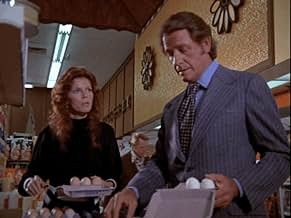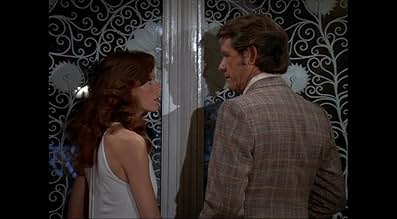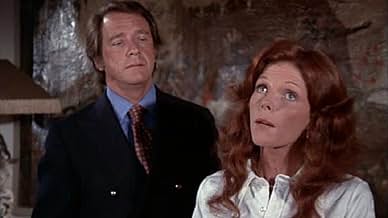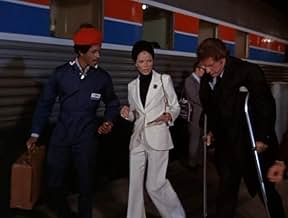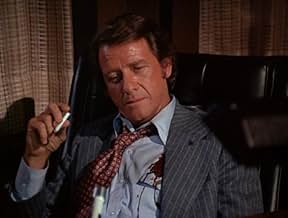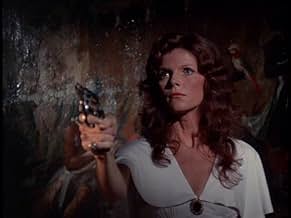अपनी भाषा में प्लॉट जोड़ेंA scheming wife lures an insurance investigator into helping murder her husband and then declare it an accident. The investigator's boss, not knowing his man is involved in it, suspects murd... सभी पढ़ेंA scheming wife lures an insurance investigator into helping murder her husband and then declare it an accident. The investigator's boss, not knowing his man is involved in it, suspects murder and sets out to prove it.A scheming wife lures an insurance investigator into helping murder her husband and then declare it an accident. The investigator's boss, not knowing his man is involved in it, suspects murder and sets out to prove it.
Arnold F. Turner
- Redcap
- (as Arnold Turner)
Rand Brooks
- Conductor
- (बिना क्रेडिट के)
Tom Curtis
- Charlie
- (बिना क्रेडिट के)
John Furlong
- George
- (बिना क्रेडिट के)
फ़ीचर्ड समीक्षाएं
This 1973 remake of the classic 1944 Billy Wilder film, "Double Indemnity," is a textbook example of how to destroy a great script. This grade-B TV fodder also illustrates the folly of remakes in general. While Hollywood has gone after greedy executives that colorize black-and-white films and sought disclaimers on wide-screen movies that are shown in pan-and-scan versions, the industry has ignored the hacks that insist on taking a classic film and diminishing it with a shoddy remake.
The first step in producing a bowdlerized version of a classic is to edit the script. The Billy-Wilder-Raymond-Chandler work was cut by a half hour to fit the finished film into a specified time-slot with room for commercials. Then update the production with bland, color photography, smart, upscale sets, and TV-familiar actors. Thus, the brand-new "Double Indemnity" eliminates the atmospheric black-and-white film-noir cinematography that enhanced the mood and characterizations of the original. Gone are the dusty, shadowy, claustrophobic sets that explained the protagonists' desires to escape their situations at whatever cost. Gone are the close bond between Keyes and Neff and the erotic attraction between Neff and Phyllis.
The look of Jack Smight's take on "Double Indemnity" is more "Dynasty" than film noir. Phyllis Dietrickson has a designer home to die for, and Neff's comfy pad would be hard to afford on an insurance salesman's salary, not to mention the sporty Mercedes convertible that he drives. Neither character has any apparent motive to murder for a paltry $200,000. If not money, then perhaps murder for love or lust? Not in this version. Richard Crenna shows little interest in Samantha Eggar, and their kisses are about as lusty as those between a brother and a sister. Crenna fails to capture the cynicism of Neff, and his attempts at double-entendre and sexual suggestiveness fall horribly flat. Eggar is little better and lacks sensuality and the depth to suggest the inner workings of a supposedly devious and manipulative mind. Only Lee J. Cobb manages a creditable performance as Keyes. Director Jack Smight and his three principals have all done much better work.
There was no conceivable reason to produce this wretched remake except to fill time in a broadcast schedule. There was no conceivable reason to resurrect this dud on DVD and package it with the original film except to fill out a double-disc package. The only lesson that can be learned from this misfire is that even a great script and great dialog can be ruined with poor casting, lackluster direction, and TV grade production values. The 1973 "Double Indemnity" should be titled "10% Indemnity," because viewing it only underscores the 100% perfection of the original movie.
The first step in producing a bowdlerized version of a classic is to edit the script. The Billy-Wilder-Raymond-Chandler work was cut by a half hour to fit the finished film into a specified time-slot with room for commercials. Then update the production with bland, color photography, smart, upscale sets, and TV-familiar actors. Thus, the brand-new "Double Indemnity" eliminates the atmospheric black-and-white film-noir cinematography that enhanced the mood and characterizations of the original. Gone are the dusty, shadowy, claustrophobic sets that explained the protagonists' desires to escape their situations at whatever cost. Gone are the close bond between Keyes and Neff and the erotic attraction between Neff and Phyllis.
The look of Jack Smight's take on "Double Indemnity" is more "Dynasty" than film noir. Phyllis Dietrickson has a designer home to die for, and Neff's comfy pad would be hard to afford on an insurance salesman's salary, not to mention the sporty Mercedes convertible that he drives. Neither character has any apparent motive to murder for a paltry $200,000. If not money, then perhaps murder for love or lust? Not in this version. Richard Crenna shows little interest in Samantha Eggar, and their kisses are about as lusty as those between a brother and a sister. Crenna fails to capture the cynicism of Neff, and his attempts at double-entendre and sexual suggestiveness fall horribly flat. Eggar is little better and lacks sensuality and the depth to suggest the inner workings of a supposedly devious and manipulative mind. Only Lee J. Cobb manages a creditable performance as Keyes. Director Jack Smight and his three principals have all done much better work.
There was no conceivable reason to produce this wretched remake except to fill time in a broadcast schedule. There was no conceivable reason to resurrect this dud on DVD and package it with the original film except to fill out a double-disc package. The only lesson that can be learned from this misfire is that even a great script and great dialog can be ruined with poor casting, lackluster direction, and TV grade production values. The 1973 "Double Indemnity" should be titled "10% Indemnity," because viewing it only underscores the 100% perfection of the original movie.
This remake of the film noir classic about a seductress and an insurance man having an affair of horror, planning the murder of her husband, gives us the same question as just about any remake.
Why the remake? Many remakes are simply film adaptations of classic novels, such as TREASURE ISLAND.
Here, though, we have what is essentially a "homage" to E.G. Robinson and the others, who made the original classic.
The crux of the story is the Columbo style E.G. character. He is always the important one. And Lee J Cobb does a fine job. In fact, he is the the entire show in this one. I don't mean to disparage Richard and Samantha, but they were very bland.
And that was probably the point, to keep them bland.
It still makes for the question "Why the remake?" Lee J Cobb tries to make this his own role. And that's okay. You really don't want to try to mimic a classic. He does okay, but there are times when E.G. just did it perfect. For example, when he says "Closer than that", E.G. was perfect. Cobb, in the effort to make it his own, knows it is taking something away when he adds "much closer", but he doesn't want to be compared too much to E.G.'s perfect portrayal.
Which is why you don't really want to remake a classic film noir.
Why the remake? Many remakes are simply film adaptations of classic novels, such as TREASURE ISLAND.
Here, though, we have what is essentially a "homage" to E.G. Robinson and the others, who made the original classic.
The crux of the story is the Columbo style E.G. character. He is always the important one. And Lee J Cobb does a fine job. In fact, he is the the entire show in this one. I don't mean to disparage Richard and Samantha, but they were very bland.
And that was probably the point, to keep them bland.
It still makes for the question "Why the remake?" Lee J Cobb tries to make this his own role. And that's okay. You really don't want to try to mimic a classic. He does okay, but there are times when E.G. just did it perfect. For example, when he says "Closer than that", E.G. was perfect. Cobb, in the effort to make it his own, knows it is taking something away when he adds "much closer", but he doesn't want to be compared too much to E.G.'s perfect portrayal.
Which is why you don't really want to remake a classic film noir.
Los Angeles insurance salesman in his late 30s is seduced by the wife of one of his clients, who gives him the idea of taking out an accident insurance policy on her husband without his knowledge. If he's killed, the wife receives $200,000--if he's killed on a train, the amount is doubled. Writer Steven Bochco had the daunting task of compressing James M. Cain's crime novel into a 75-minute movie for television. Bochco must have known how unnecessary the whole idea was, especially since no amount of effort could even hope to get the project out from the shadow of Billy Wilder's classic 1944 version. The three leads (Richard Crenna and Samantha Eggar as the illicit lovers, Lee J. Cobb as Crenna's boss) go through the motions dutifully, but nothing here feels fresh.
Utter dreck. I got to the 16 minute/27 second point, and gave up. I'd have given it a negative number review if that were possible (although 'pissible' is a more fitting word...). Unlike the sizzle you could see and practically feel between MacMurray and Stanwyck in the original, the chemistry between dumb ol' Dicky Crenna and whats-her-face here is just non-existent. The anklet becomes an unattractive chunky bracelet? There's no ciggy-lighting-by-fingertip? And I thought I'd be SICK when they have a mortified-looking (and rightly so, believe you me) Lee J. Cobb as Keyes practically burping/upchucking his way through the explanation of his "Little Man" to Mr. Garloupis. No offence to the non-sighted, but it looks as though a posse of blind men ran amuck with the set design of both the Dietrichson and Neff houses. The same goes for those horrid plaid pants that Phyllis wears. And crikey, how much $$ does Neff make, that he lives overlooking a huge marina? This, folks, again, all takes place in the first 16 and a half minutes. If you can get through more of it, you have a much stronger constitution than me, or you are a masochist. But please, take some Alka-Seltzer first, or you WILL develop a "little man" of your own that may never go away. Proceed with caution, obviously.
It was hard to watch this film and be totally fair and objective since I am a big fan the original 1944 movie. That, to me and many others, is one of the greatest film noirs ever made. Realizing this is simply a shortened made-for-TV film and that most people had trashed it, I didn't expect much, but you can't help but compare this with the '44 film. Scene after scene, I found myself comparing what I was looking at it, and remembering how it played out with Fred MacMurray, Barbara Stanwyck, Edward G. Robinson and others. Now I was seeing these famous actors playing their famous roles replaced by Richard Crenna, Samantha Eggar and Lee J. Cobb.
When it was all over, I found it wasn't as bad as I had expected but it's no match for the 1944 original. The two main areas in which this made-for-TV film wasn't as good were (1) the electricity between the two leads was missing and (2) being only 90 minutes, they rushed the story with hardly time to develop the plot, characters and chemistry between those leads. Crenna and Eggar were flat, and simply no match for MacMurray and Stanwyck as "Walter Neff" and "Phyllis Dietrichson," respectively.
Where this re-make held its own was in the other characters, such as "Barton Keyes" and "Edward Norton." Cobb was terrific as Keyes and Robert Webber as Norton, head of the insurance company. It also was somewhat interesting to see the time frame changed, so the houses, cars, telephones, dictating machines, etc., were all early '70s instead of mid '40s. Otherwise, the storyline was very similar, just rushed.
However, one viewing was enough and I will happily go back to the original version for the rest of my viewings of this classic story and film.
When it was all over, I found it wasn't as bad as I had expected but it's no match for the 1944 original. The two main areas in which this made-for-TV film wasn't as good were (1) the electricity between the two leads was missing and (2) being only 90 minutes, they rushed the story with hardly time to develop the plot, characters and chemistry between those leads. Crenna and Eggar were flat, and simply no match for MacMurray and Stanwyck as "Walter Neff" and "Phyllis Dietrichson," respectively.
Where this re-make held its own was in the other characters, such as "Barton Keyes" and "Edward Norton." Cobb was terrific as Keyes and Robert Webber as Norton, head of the insurance company. It also was somewhat interesting to see the time frame changed, so the houses, cars, telephones, dictating machines, etc., were all early '70s instead of mid '40s. Otherwise, the storyline was very similar, just rushed.
However, one viewing was enough and I will happily go back to the original version for the rest of my viewings of this classic story and film.
क्या आपको पता है
- ट्रिवियाBilly Wilder (the co-writer and director of the original version, Double Indemnity (1944)) and Barbara Stanwyck (who played Phyllis in the original version) both saw the film in their respective homes when it broadcast. When it was over, Wilder immediately phoned Stanwyck, said, "Missy, they just didn't get it right," and hung up.
- कनेक्शनVersion of Double Indemnity (1944)
टॉप पसंद
रेटिंग देने के लिए साइन-इन करें और वैयक्तिकृत सुझावों के लिए वॉचलिस्ट करें
विवरण
- रिलीज़ की तारीख़
- कंट्री ऑफ़ ओरिजिन
- भाषा
- इस रूप में भी जाना जाता है
- Doble indemnización
- फ़िल्माने की जगहें
- उत्पादन कंपनियां
- IMDbPro पर और कंपनी क्रेडिट देखें
- चलने की अवधि
- 1 घं 14 मि(74 min)
- ध्वनि मिश्रण
- पक्ष अनुपात
- 1.33 : 1
इस पेज में योगदान दें
किसी बदलाव का सुझाव दें या अनुपलब्ध कॉन्टेंट जोड़ें

